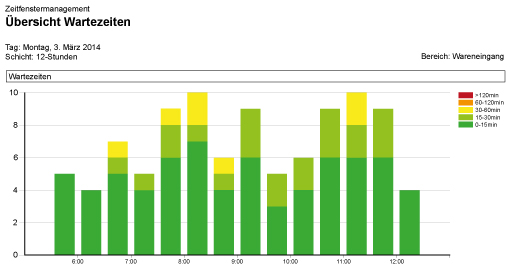Time slot management
Time slot management (also called time slot control or ramp management ) describes the coordination of all loading and unloading processes at the loading ramp in logistics .
General
The best possible coordination of these processes is necessary in order to ensure that production is supplied on time and that the end customers are supplied with the finished products on time.
Time slot management is relevant for the manufacturing industry as well as for the logistics service providers and freight forwarders involved . They often have to announce their pick-ups or deliveries and book a time slot in advance . Two problems often arise. On the one hand, the logistics service providers wait a long time at the loading ramps despite the booked time slots , and on the other hand there is a lack of information.
The problem of long waiting times at loading ramps is a constant issue, especially in retail . Here, time windows are often given to the forwarding agents and logistics service providers. However, in the event of non-compliance due to traffic jams or other delays, the time slots cannot be allocated elsewhere. As a result, many resources are wasted and usage is erratic. If logistics service providers arrive too late at the loading ramp, their booked time slot often expires. Greater flexibility would be desirable, so that waiting vehicles can be loaded earlier than planned and delayed trucks are given a different time window for loading. In addition, associations such as the Federal Association of Economy, Transport and Logistics (BWVL) demand that express ramps and longer opening times be offered.
Use in practice
In practice, the handling of the allocation of time windows differs from branch to branch. However, most IT systems for time slot management require freight forwarders and logistics service providers to book a time slot at least 24 hours in advance. This means a high loss of time for freight forwarders who cannot deliver or collect the goods to be handled immediately. As a result, it sometimes takes more than a day before the goods can be transported and ultimately delays the processes. Problems also arise because the cooperation between shippers and logistics service providers is not yet working optimally. One reason for this is the lack of data.
If the forwarding agents are only notified of the delivery manually by fax or telephone, the delivery trucks and the necessary resources cannot be planned . An IT system could lead to a partnership cooperation lead and propose meaningful time frame based on the quantity of the goods. In addition, this would also make incoming goods inspections easier, as it would already be clear which goods are being delivered and when. Then only deviations such as a varying amount would have to be checked.
Outlook and possibilities of time slot management
All companies that goods producing and transporting, loading their goods at loading ramps. Loading ramps are required for loading and unloading both for deliveries from suppliers and for dispatch to customers. For smaller companies, the coordination of the time windows and the individual ramps runs smoothly and no fixed appointments are required in advance.
For corporations or manufacturing companies that need certain goods at a certain point in time, the coordination of times, ramps, parking spaces and the required human resources often leads to problems. However, if the status data of the delivering trucks are included in the time slot management and an IT system intelligently processes this information, time slots could be assigned based on the actual current load. The truck driver could submit his status reports via smartphone while on the move and display a delay in real time . This would make it possible to use unneeded time windows and reduce waiting times. The professional drivers could also support an app that would be connected to the time slot management system. This could provide information on current waiting times and navigate the driver not only to the correct address, but also to a free parking space or the correct loading ramp .
literature
- Andreas Richter: Dynamic route planning: Basics and procedures. AV Akademikerverlag, 2012, ISBN 978-3-639-45098-9 .
- David Schipior: Transport and route planning: procedures and software for solving complex route planning problems. Diplomica Verlag, 2012, ISBN 978-3-8428-9253-8 .
Trade journals
Web links
- GS1 Germany website with standardization recommendations for time slot control
- Information portal on the topic of ramp management .
- Study by the Federal Office for Goods Transport
- IT system to control ramps, time slots and resources
- Reference study: time slot management at Lufthansa Cargo
References and comments
- ↑ Stefan Hagenlocher / Frank Wilting / Paul Wittenbrink: Interface ramp - solutions for avoiding waiting times . Society for Transport and Management Consulting hwh, April 2013, OCLC 854717292 .
- ↑ Report of the BWVL on the problem at the loading ramps
